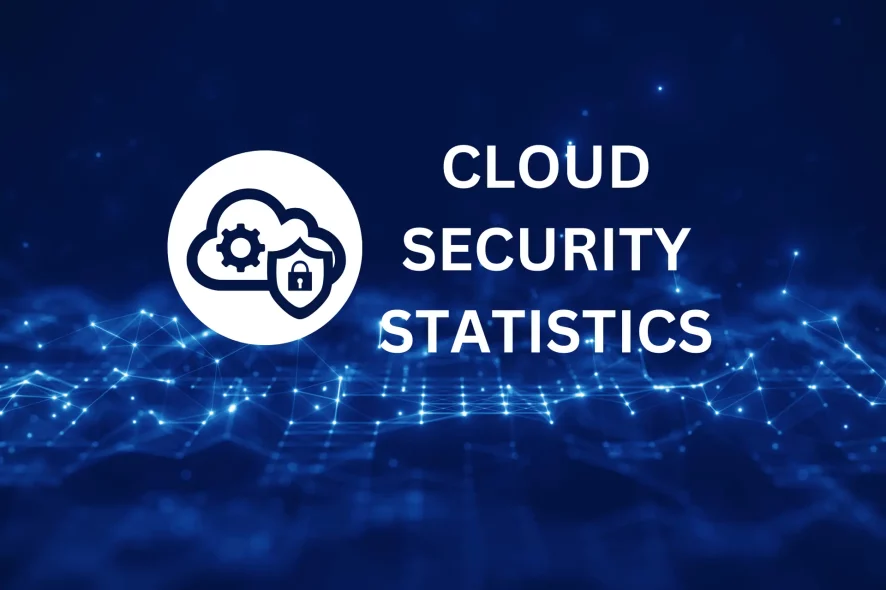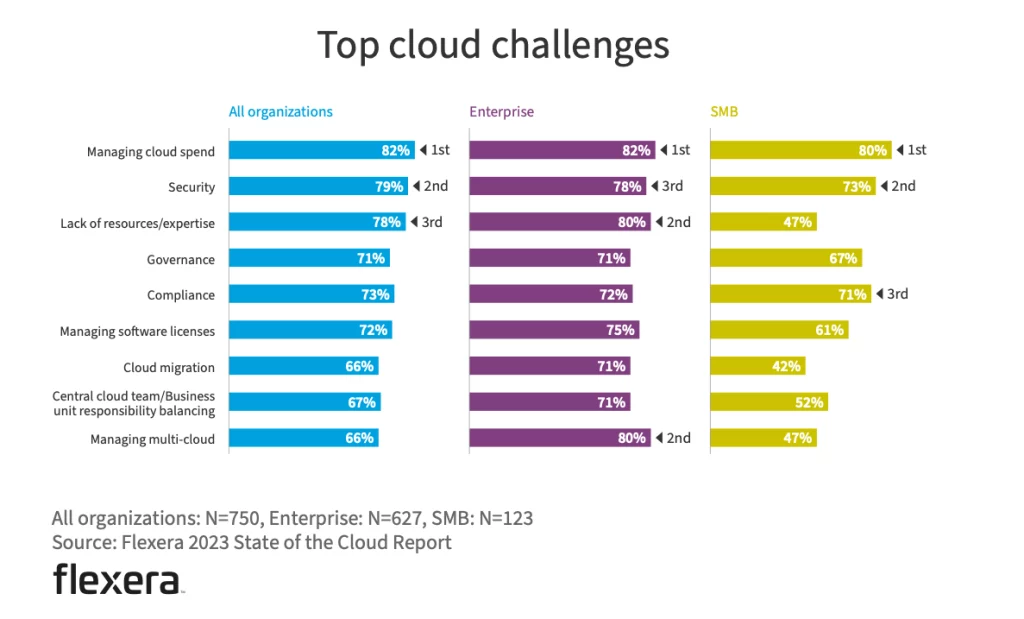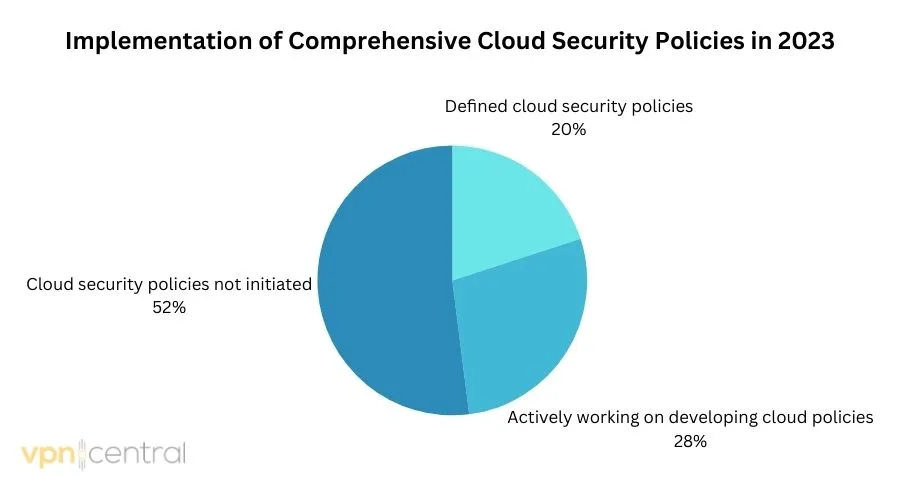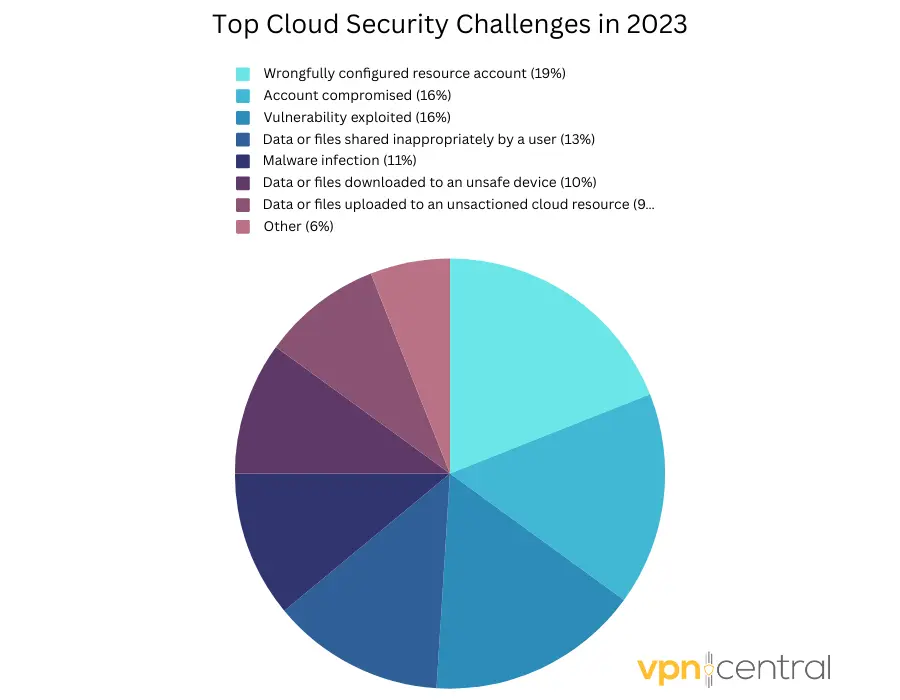14 Eye-Opening Cloud Security Statistics You Can't Ignore in 2025
As organizations increasingly adopt cloud computing, security challenges escalate
7 min. read
Updated on
Read our disclosure page to find out how can you help VPNCentral sustain the editorial team Read more

Cloud security statistics show that cloud computing is invaluable for many organizations looking to store data safely.
With serious growth in cloud computing solutions in organizations comes a pressing need for heightened security measures.
Without proper implementation, this infrastructure can be just as unsafe as any other IT centralized storage service.
Unsurprisingly, poor configuration is one of the biggest challenges in cloud security. Even though 3/4 of organizations trust the cloud with their data, less than 1/4 use proper encryption.
Let’s delve deeper and explore more of these cloud security stats.
Eye-Catching Cloud Security Statistics
These are the astonishing cloud security statistics you may not be aware of:
- 75% of organizations stored sensitive data in the cloud in 2023
- The cloud computing market is dominated by 3 major players
- Only 22% of organizations encrypt the majority of their cloud data
- 37% of engineering leaders struggle to find tools that operate across various clouds
- Security is the second biggest challenge for all organizations that employ cloud computing
General Cloud Security Statistics
Data shows organizations trust cloud computing solutions more and more. In line with this, the adoption of cloud VPNs is expected to grow significantly in the following years.
1. 3 major services dominated the cloud market in 2023
(Source: Statista)
According to a Statista report in 2023, Amazon Web Service, Microsoft Azure, and Google Cloud Platform were the top three cloud service providers.
- 32% of the users used Amazon Web Service.
- 22% of users used Microsoft Azure.
- 11% of the users used Google Cloud Platform.

2. The cloud VPN market is expected to reach $26.01 billion in 5 years.
(Source: Mordor Intelligence)
The cloud VPN market is valued at USD 7.67 billion in 2023 and is expected to rise by almost 240% until 2028.
Some of the most significant market drivers include:
- Increasing BYOD (bring your own device) and enterprise mobility
- Growing data concerns regarding remote workers
- Cloud migrations and the shift from on-premise to data centers
- Rising demand for secure remote access and private cloud adoption
The need for better security in cloud computing is a direct driver of this expected growth.
3. 75% of organizations stored sensitive data in the cloud in 2023, up from 49% in 2021.
(Source: Thales)
There has been a significant increase in the amount of confidential/sensitive data stored in the cloud.
75% of respondents of Thales Group’s study report that 40% or more of their data in the cloud is sensitive.
This reflects organizations trust cloud solutions with their data more but also highlights the growing importance of securing critical information in cloud environments.
Cloud Security Statistics
Cloud security in 2023 faces challenges as incidents continue to persist.
Concerns span from misconfigurations, compromised accounts, and exploited vulnerabilities.
4. Security was the second biggest cloud challenge for all organizations in 2023.

(Source: Flexera)
According to Flexera, this is the first time that managing cloud spending overtakes security as the biggest problem organizations that use cloud environments face.
This showcases the impact of global economics, rather than an improvement in overall security practices in cloud security.
5. Less than half of organizations implemented comprehensive cloud security policies in 2023.
(Source: Pluralsight)
Only 20% of organizations have defined cloud policies, disaster recovery plans, SLA policies, and cloud governance, while 28% are actively working on developing them.
Merely 13% have completed the migration and refactoring of all legacy systems.

6. 80% of organizations experienced serious cloud security incidents in 2021.
(Source: Snyk)
These incidents include data breaches (25%), data leaks (26%), and environment intrusions (27%). Cryptomining, compliance violations, and system downtime due to misconfiguration were also reported.
This further highlights the need for a well-established security policy across cloud environments.
7. 59% of cybersecurity professionals see misconfiguration as the biggest security threat in public clouds.
(Source: Check Point)
The wrong setup or configuration of the cloud platform is the number one threat in cloud computing, according to experts surveyed by Check Point.
In contrast, only 38% view malware/ransomware attacks and malicious insiders as threats.
8. 24% of organizations employing cloud technologies faced security challenges in 2023.
(Source: Check Point)
A recent study by Check Point indicates that organizations continue to grapple with security incidents, with 24% reporting issues.
The top challenges include wrongly configured resources or accounts (19%), account compromises (16%), and exploited vulnerabilities (16%).

These findings underscore the critical need to address misconfigurations and vulnerabilities across the entire cloud infrastructure.
9. Only 22% of organizations use encryption for the majority of their data.
(Source: Thales)
A recent study exposes significant vulnerabilities in cloud data security, revealing that only 22% of IT professionals encrypt over 60% of sensitive data in the cloud, with an average of just 45% of cloud data being encrypted.
This concerning trend raises questions about the overall safety of sensitive information stored in cloud environments.
Cloud adoption statistics
Though most organizations store at least some of their data in the cloud, the high cost, lack of tools that operate in multi-clouds, and security problems make the transition from on-premise data storing solutions to the cloud take longer than desired.
10. Lack of security skills and data privacy challenges were top concerns in public cloud adoption in 2020.
(Source: IDG)
IDG’s Cloud computing survey underscores that the lack of security skills and data privacy and security challenges are major hurdles in the realm of public cloud adoption. 30% of respondents identify the lack of cloud security skills and expertise as a significant challenge.
Moreover, data privacy and security challenges are reported by 38% of respondents.
These statistics highlight the critical need for skilled professionals and robust security measures to address the evolving landscape of threats and regulatory compliance in the public cloud.
11. 4 out of 5 cloud computing customers want egress charges removed.
(Source: Ofcom)
Data egress fees are what cloud providers charge when you move your data out of their storage.
78% of respondents in 2023 customer research done by Ofcom believe that these fees should be reduced or removed.
They represent another challenge organizations have to face when managing and implementing cloud computing solutions.
12. 37% of engineering leaders struggle to find tools that operate across various clouds.
(Source: Datanami)
Among engineering leaders that adopted the world of multi-cloud, a substantial 37% express concern about the integration struggle.
These organization seniors, while recognizing the undeniable perks of multi-cloud strategies, find themselves in a bit of a bind. Imagine having your data and applications scattered across different clouds like pieces of a puzzle that just won’t click together seamlessly.
Cloud Security Trends
Most IT decision-makers opt for cloud-based instead of on-premise solutions. Additionally, more and more organizations are looking to implement comprehensive policies, regardless of sector.
13. 57% of organizations have increased migration to the cloud in the past year
(Source: Foundry)
While the adoption rate isn’t shooting up as fast as it did during the pandemic, many organizations are still embracing cloud computing at a remarkable rate.
Most of the enterprise workload is expected to be done in the cloud by 2025.
Not only that, when it comes to implementing new tech solutions, most (65%) of IT decision-makers opt for cloud instead of on-premise options.
14. The global cybersecurity mesh market is expected to grow from $0.9 billion in 2023 to $2.6 billion in 2027.
(Source: Market and Markets)
Anticipated to grow from USD 0.9 billion in 2023 to USD 2.6 billion by 2027, the global cybersecurity mesh market is set for remarkable growth at a CAGR (compound annual growth rate) of 28.6%.
Notably, there’s a substantial demand for cybersecurity mesh solutions spanning diverse sectors, including IT & ITeS, BFSI, healthcare, energy, and utilities.
This expansion is set in motion by the increasing cybersecurity threats faced by organizations.
Wrap Up
Cloud security statistics emphasize the rising popularity and growing concerns involving cloud computing.
Many organizations fear being left behind by not adopting the cloud infrastructure. On the other hand, many enterprises are contending with keeping their sensitive data safe from cloud cyber-attacks.
All in all, organizations that use cloud computing should take proactive approaches to strengthen security.
Sources:









User forum
0 messages